The iPhone 5 Review
by Anand Lal Shimpi, Brian Klug & Vivek Gowri on October 16, 2012 11:33 AM EST- Posted in
- Smartphones
- Apple
- Mobile
- iPhone 5
GPU Analysis/Performance
Section by Anand Shimpi
Understanding the A6's GPU architecture is a walk in the park compared to what we had to do to get a high level understanding of Swift. The die photos give us a clear indication of the number of GPU cores and the width of the memory interface, while the performance and timing of release fill in the rest of the blanks. Apple has not abandoned driving GPU performance on its smartphones and increased the GPU compute horsepower by 2x. Rather than double up GPU core count, Apple adds a third PowerVR SGX 543 core and runs the three at a higher frequency than in the A5. The result is roughly the same graphics horsepower as the four-core PowerVR SGX 543MP4 in Apple's A5X, but with a smaller die footprint.
As a recap, Imagination Technologies' PowerVR SGX543 GPU core features four USSE2 pipes. Each pipe has a 4-way vector ALU that can crank out 4 multiply-adds per clock, which works out to be 16 MADs per clock or 32 FLOPS. Imagination lets the customer stick multiple 543 cores together, which scales compute performance linearly.
SoC die size however dictates memory interface width, and it's clear that the A6 is significantly smaller in that department than the A5X, which is where we see the only tradeoff in GPU performance: the A6 maintains a 64-bit LPDDR2 interface compared to the 128-bit LPDDR2 interface in the A5X. The tradeoff makes sense given that the A5X has to drive 4.3x the number of pixels that the A6 has to drive in the iPhone 5. At high resolutions, GPU performance quickly becomes memory bandwidth bound. Fortunately for iPhone 5 users, the A6's 64-bit LPDDR2 interface is a good match for the comparatively low 1136 x 640 display resolution. The end result is 3D performance that looks a lot like the new iPad, but in a phone:
| Mobile SoC GPU Comparison | |||||||||||
| Adreno 225 | PowerVR SGX 540 | PowerVR SGX 543MP2 | PowerVR SGX 543MP3 | PowerVR SGX 543MP4 | Mali-400 MP4 | Tegra 3 | |||||
| SIMD Name | - | USSE | USSE2 | USSE2 | USSE2 | Core | Core | ||||
| # of SIMDs | 8 | 4 | 8 | 12 | 16 | 4 + 1 | 12 | ||||
| MADs per SIMD | 4 | 2 | 4 | 4 | 4 | 4 / 2 | 1 | ||||
| Total MADs | 32 | 8 | 32 | 48 | 64 | 18 | 12 | ||||
| GFLOPS @ 200MHz | 12.8 GFLOPS | 3.2 GFLOPS | 12.8 GFLOPS | 19.2 GFLOPS | 25.6 GFLOPS | 7.2 GFLOPS | 4.8 GFLOPS | ||||
We ran through the full GLBenchmark 2.5 suite to get a good idea of GPU performance. The results below are largely unchanged from our iPhone 5 Performance Preview, with the addition of the Motorola RAZR i and RAZR M. I also re-ran the iPad results on iOS 6, although I didn't see major changes there.
We'll start out with the raw theoretical numbers beginning with fill rate:
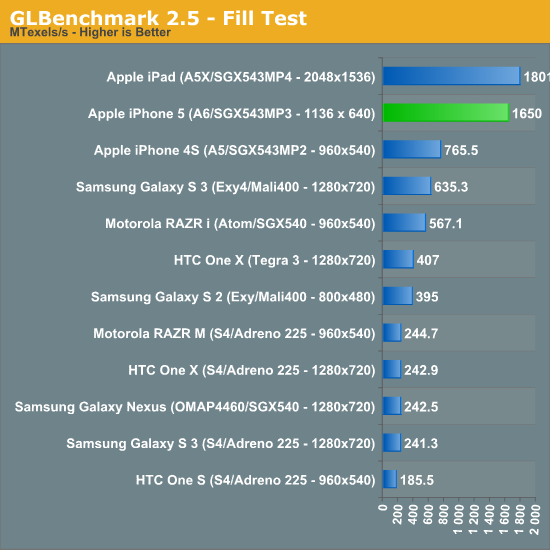
The iPhone 5 nips at the heels of the 3rd generation iPad here, at 1.65GTexels/s. The performance advantage over the iPhone 4S is more than double, and even the Galaxy S 3 can't come close.
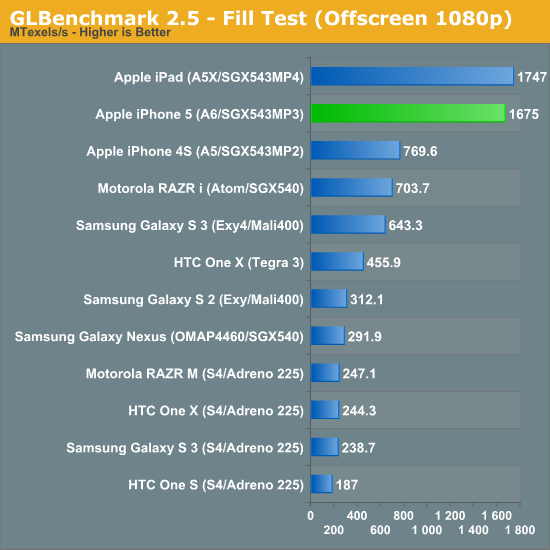
Triangle throughput is similarly strong:

Take resolution into account and the iPhone 5 is actually faster than the new iPad, but normalize for resolution using GLBenchmark's offscreen mode and the A5X and A6 look identical:
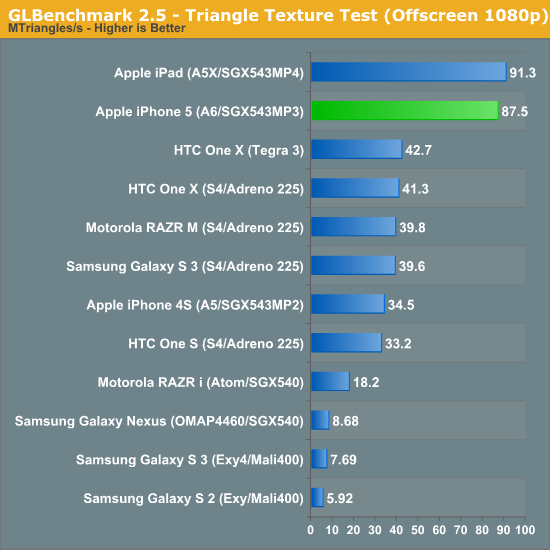
The fragment lit texture test does very well on the iPhone 5, once again when you take into account the much lower resolution of the 5's display performance is significantly better than on the iPad:
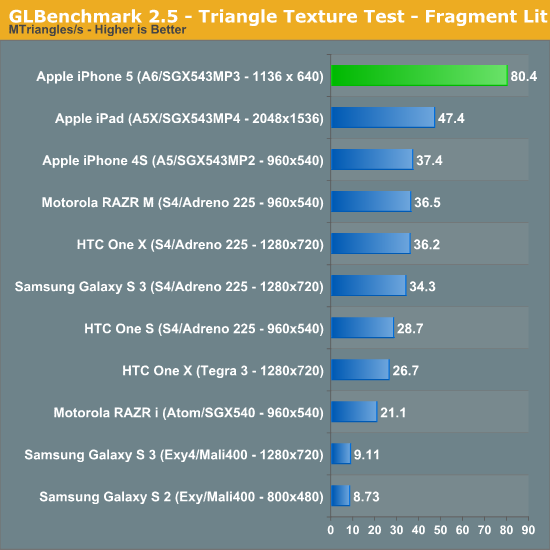
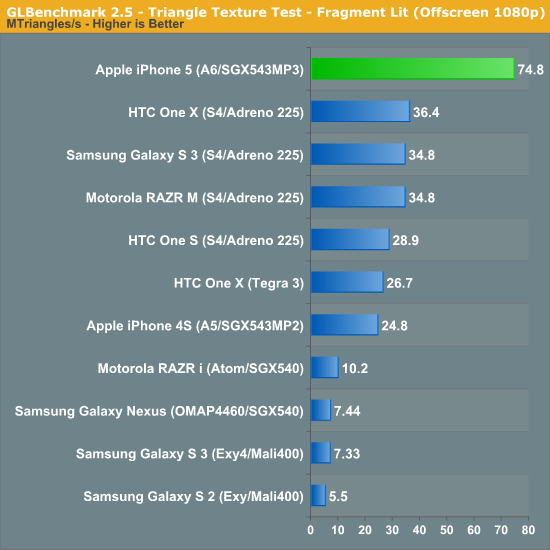

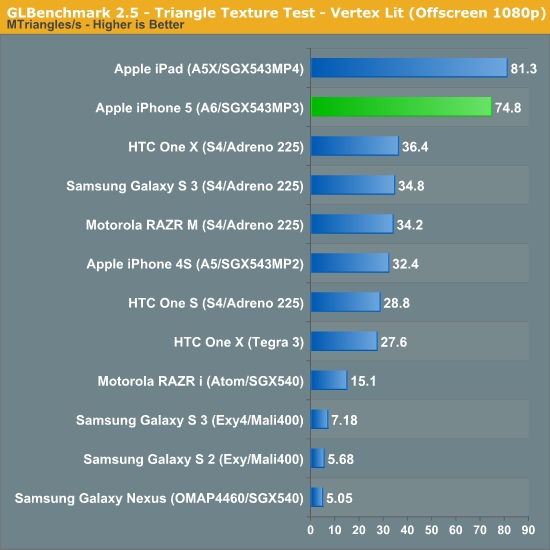
The next set of results are the gameplay simulation tests, which attempt to give you an idea of what game performance based on Kishonti's engine would look like. These tests tend to be compute monsters, so they'll make a great stress test for the iPhone 5's new GPU:
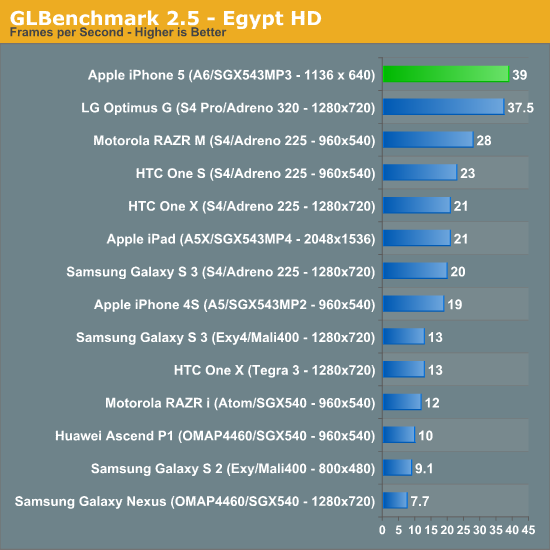
Egypt HD was the great equalizer when we first met it, but the iPhone 5 does very well here. The biggest surprise however is just how well the Qualcomm Snapdragon S4 Pro with Adreno 320 GPU does by comparison. LG's Optimus G, a device Brian flew to Seoul, South Korea to benchmark, is hot on the heels of the new iPhone.
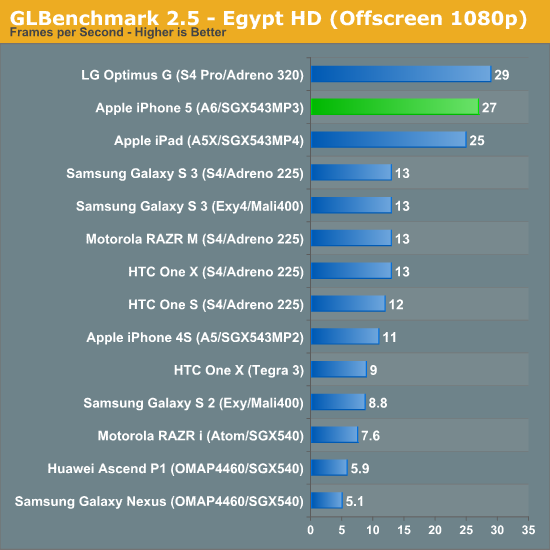
When we run everything at 1080p the iPhone 5 looks a lot like the new iPad, and is about 2x the performance of the Galaxy S 3. Here, LG's Optimus G actually outperforms the iPhone 5! It looks like Qualcomm's Adreno 320 is quite competent in a phone. Note just how bad Intel's Atom Z2460 is, the PowerVR SGX 540 is simply unacceptable for a modern high-end SoC. I hope Intel's slow warming up to integrating fast GPUs on die doesn't plague its mobile SoC lineup for much longer.
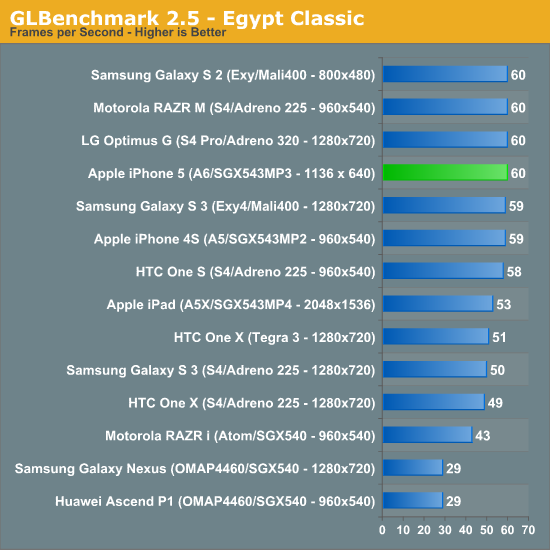
The Egypt classic tests are much lighter workloads and are likely a good indication of the type of performance you can expect from many games today available on the app store. At its native resolution, the iPhone 5 has no problems hitting the 60 fps vsync limit.
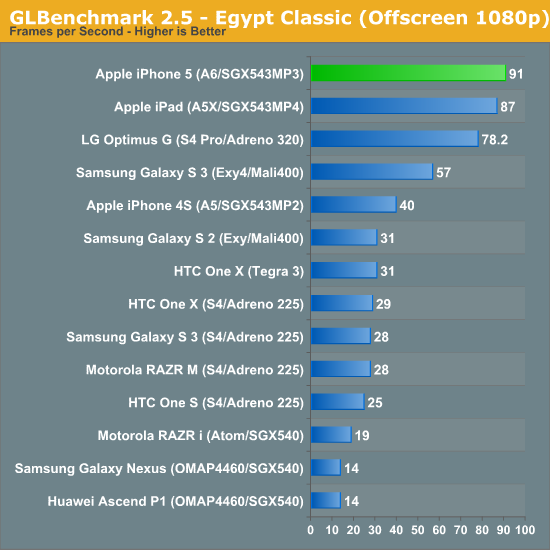
Remove vsync, render at 1080p and you see what the GPUs can really do. Here the iPhone 5 pulls ahead of the Adreno 320 based LG Optimus G and even slightly ahead of the new iPad.
Once again, looking at GLBenchmark's on-screen and offscreen Egypt tests we can get a good idea of how the iPhone 5 measures up to Apple's claims of 2x the GPU performance of the iPhone 4S:
Removing the clearly vsync limited result from the on-screen Egypt Classic test, the iPhone 5 performs about 2.26x the speed of the 4S. If we include that result in the average you're still looking at a 1.95x average. As we've seen in the past, these gains don't typically translate into dramatically higher frame rates in games, but games with better visual quality instead.











276 Comments
View All Comments
ArmedandDangerous - Tuesday, October 16, 2012 - link
What ever happened to the One X International review that was promised when you were reviewing the US version? Lots of promised articles and reviews that were never ever done...MrCake - Wednesday, October 17, 2012 - link
Yeah, already posted this comment for podcast 8, but it bears repeating. I'm less angry now, but still facepalming.It's not my expertise but I have designed a few hundred aluminum parts, so here's how it probably
works. The call-out is most likely equivalent to mil-std-171 7.2.2; this is a ~.0005" thickness coat,
decorative and scratch resistant. The coating itself is super hard, and can only be scratched by harder materials. The problem is the base metal yield strength is still fairly low. Chamfers (yes, we do pronounce the "h") have sharp edges, which make point contacts and therefore have theoretically infinite contact stresses till they're rounded off. To summarize; small contact areas, equal high pressures even at low forces; pressures over material yield cause deformations, and deformations over .0005" make you see silver. The chamfer finish is probably not a post anodization process,it's diamond ground and has a much finer surface finish. The rest of the phone is cnc milled, and is matte from either a sandblasting, or vibratory media process to remove machining marks. Anodize surfaces are as glossy/matte as their surface finish. And as to the "structural integrity" concern repeated, and repeated, and repeated; The iphone is thin, but the anodize coating is a couple orders of magnitude thinner and has negligible affect on structural integrity.
A possible fix would be mil-std-171 7.5.2 Anodize Type III which is an anodized hardcoat. It's a
similar process but coats to .002" thick, packs it's molecules much denser, and can pass a hardness test to rockwell C60. It's a reasonable response to the scratching issue, however it may not be appropriate for other reasons(prone to cracking instead of scratching, tolerance issues, more costly, less pretty.)
syxbit - Wednesday, October 17, 2012 - link
Great job guys. I'd appreciate it if you went into as much detail on the upcoming Nexus device(s).KPOM - Wednesday, October 17, 2012 - link
They will.WooDaddy - Wednesday, October 17, 2012 - link
I didn't RTFA (as if I need to question Anand consistently excellent analysis as it has been Anandtech's inception), but as soon as I saw the phrase 'murdered out' regarding the black/slate color, I was done. It was like Anand was at a poetry slam and he dropped the mic signifying that there is no one better.VivekGowri - Wednesday, October 17, 2012 - link
Hey, hey, I wrote that part :Pjuhatus - Wednesday, October 17, 2012 - link
iPhone review.. what about..Does it work as a phone??
SJD - Wednesday, October 17, 2012 - link
Don't know if I'm the first one to say this, but the HTC One S battery isn't removable. (At least it isn't over here in the UK - don't know if your version in the US is any different).Table - Physical Comparison - Page 1
Origin64 - Wednesday, October 17, 2012 - link
I do really want to point out that the iPhone 5 being 20% lighter than the 4 isn't really substantial, seeing as how a Galaxy S 1 weighs about half of that.Apple has excellent construction quality, but they build their phones from glass and aluminium and they are heavier than the competition. There's no advantage here, no breakthrough, the iPhone 5 is just a different design that has a thinner battery and less glass. It's not as interesting as you make it seem.
thunng8 - Wednesday, October 17, 2012 - link
What are you on about? The Galaxy S weighs 119g and the iphone 5 weighs 112g.